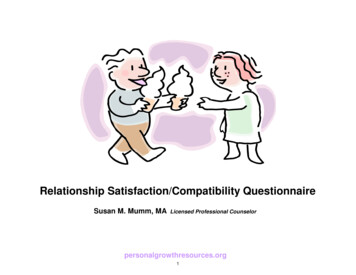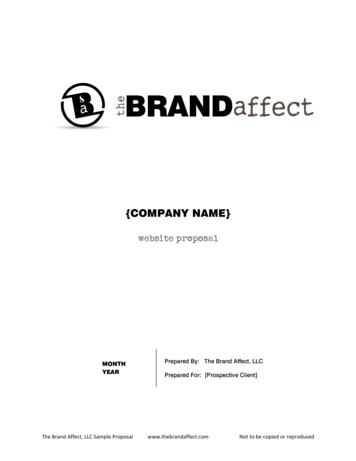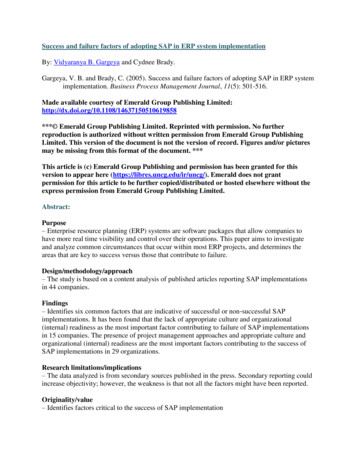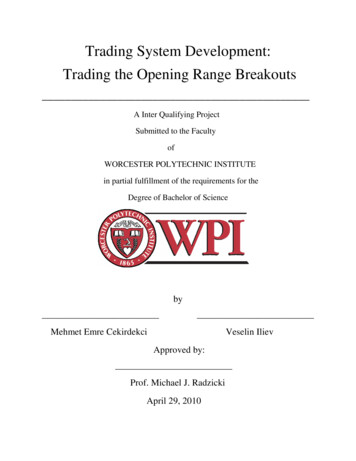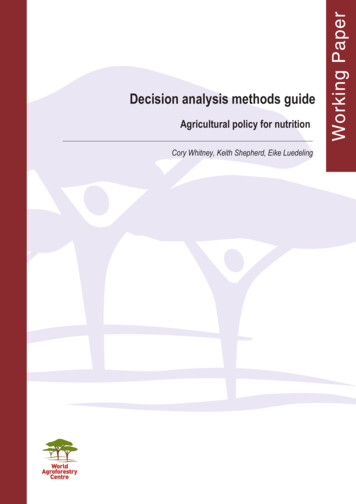
Transcription
International Journal of Forestry and Horticulture (IJFH)Volume 5, Issue 1, 2019, PP 12-19ISSN No. (Online) 2454–9487DOI: cjournals.orgReview on Factors which Affect Coffee (Coffea Arabica L.)Quality in South Western, EthiopiaHabtamu Deribe *Department of Plant Science College of Agriculture and Natural Resource, Bonga university BongaEthiopia*Corresponding Authors: Habtamu Deribe, Department of Plant Science College of Agriculture andNatural Resource, Bonga university Bonga EthiopiaAbstract: Coffee is the most important crop in the national economy of Ethiopia and the leading exportcommodity. Ethiopia is well known not only for being the home of Arabica coffee, but also for it is very finequality coffee acclaimed for its aroma and flavor characteristics. Coffee quality is of critical importance tothe coffee industry. Cup quality is a complex characteristic which depends on a series of factors such as thespecies or variety (genetic factors), environmental conditions (ecological factors), agronomical practices(cultivation factors), processing systems (postharvest factors), storage conditions, industrial processing,preparation of the beverage and taste of the consumer. However, in Ethiopia the quality of coffee producedby farmers has been deteriorating from time to time. Moreover, factors that determine coffee quality aregenotypes, climatic conditions, and soil characteristics of the area, agronomic practices, harvesting methodsand timing, postharvest processing techniques, grading, packing, storage conditions and transporting, allcontribute either exaltation or deterioration of coffee.Keywords: coffee, quality, factors1. INTRODUCTIONCoffee is a perennial field crop which belongs to the genus Coffea in the Rubiaceae family, and ismostly grown in the tropical and subtropical regions (Berthaud and Charrier, 1988).Almost all thecoff ee species are diploid (2n 2x 22) and generally self-incompatible except C. Arabica which is anatural allotetraploid (2n 4x 44) self-fertile species(Charrier and Berthaud, 1985). About 124species of the genus Coffea have been identified so far (Davis et al., 2012). Coffea Arabica is knownto be one of the most important beverages in the world and is a very important source of foreignexchange for many countries (Labouisse et al., 2008). In the consumer market, C. Arabica is preferredfor its beverage quality, aromatic characteristics, and low-caff eine content compared to Robusta,which is characterized by a stronger bitterness, and higher-caff eine content. Arabica contributestowards 65% of global coff ee production (L ecolier et al., 2009).Ethiopia had been the origin of coffee since coffee plant was initially found and cultivated in theKaffa province (Bonga, Makira) of Ethiopia (UNCTAD/WTO, 2002). Ethiopia is the primary centerof origin and center of genetic diversity of Coffea Arabica L. and the existence of such geneticdiversity provides immense opportunity for coffee improvement (Fikadu et al., 2008).Ethiopia is the primary center of origin and center of genetic diversity of Coffea Arabica L. and theexistence of such genetic diversity provides immense opportunity for coffee improvement (Fikadu etal., 2008).Ethiopia is the home and cradle of biodiversity of Arabica coffee seeds and also it is thecenter for origin, diversification, and dissemination of the coffee plant (Bayetta, 2001).According toCSA, (2017), the estimated area of land covered by coffee in Ethiopia is about 700474.69 ha, whereasthe estimated annual national production of clean coffee is about 469091.12 tons with averageproductivity of 669.6 kg ha-1.Ethiopia remains the largest producer of coffee in Africa and is the fifth largest coffee producer in theworld next to Brazil, Vietnam, Colombia and Indonesia, contributing to about 4.2% of the total worldcoffee production (ICO, 2016).Coffee is one of the leading traded commodities on the global marketin both volume and value (Zewdu, 2016). The world coffee production is estimated at approximately8.75 million tons which are accounted for about 23.4 billion US dollar in export value in 2013.International Journal of Forestry and Horticulture (IJFH)Page 12
Review on Factors which Affect Coffee (Coffea Arabica L.)Quality in South western, EthiopiaArabica coffee is cultivated in 85% of the coffee producing countries, and the American Continentaccounts for approximately 60-70% of the world coffee production (ICO, 2014). The coffee sectoremploys more than 100 million people in different parts of the World (Petit, 2007). In the globalmarket, coffee is a strategic crop since it is a primary source of livelihood for many farmers (ITC,2011).In Ethiopia, the coffee is produced within specific agro-ecological zones, in several geographical andpolitical boundaries. The main coffee-production areas of Ethiopia are the south-west and south-east,with modest and minor production in the north part of the country. According to Davis et al., (2017),stated that “coffee production had been negatively influenced by changes in climate”. Coffeeproduced in different production systems that include forest, semi-forest, garden, and a modernplantation. There are differences of opinion on the amount of farm size for coffee production area bysmallholders. More than 90 percent of coffee produced in the country comes from smallholderfarmers, and the rest 10 percent is from medium and large scale producers (USDA, 2016). Themajority of production is on the small garden field and on average less than 2 hectares with yieldsremaining low at around 0.7 - 0.8 metric tons per hectare (USDA, 2016). The production is mainly bysmallholder farmers on average reported about 0.67 ha.Major factors such as predominant use of unimproved local coffee landraces, as well as conventionalhusbandry and processing practices, which in turn seriously hampers the overall national coffeeproduction and productivity of the smallholder coffee farmers in the country (Taye, 2010).Ethiopiaexports its coffee based on their areas of origin (type), which are known for their own distinct qualityand agronomic characters (MoARD, 2008). Musebe et al. (2007) reported that coffee quality isdetermined by 40% in the field, 40% at postharvest primary processing and 20% at secondaryprocessing and handling practices. However, there are a lot of factors which deteriorate the quality ofcoffee produced in the areas. This is mainly due to poor management of agronomic practices, poorpost-harvest management, shortages of processing technologies (wet & dry process) and storagepractices. Therefore, the gap of those challenges can affect marketing linkages of coffee in nationaland international levels. Therefore, the main objective of this review is to review factors which affectquality coffee productin Southwestern Ethiopia.1.1. Coffee Production in EthiopiaCoffee is Ethiopia‟s largest export crop, (Petit, 2007). Ethiopia produces only Arabica coffee which isconsidered as superior to Robusta coffee due to its fine aroma, strong body, and pleasant acidity(Zewdu, 2016). The country produces premium quality Arabica coffee in Africa and is the thirdlargest producer in the world (ICO, 2014). A quarter of the total population of Ethiopia is directly orindirectly dependent on the income they generate from growing coffee for their livelihood(Zewdu,2016). The coffee production sector in Ethiopia is being supported by both Regional andFederal Governments (Berhanu, 2017). The country has enormous potential to become the leadingcoffee producer in the world, (Gole, 2015), primarily because of quality characteristics of the coffee(Alemseged, 2012). The Ethiopian coffee is characterized by its rich in aroma and flavor makes itdesirable for blending with coffee from other countries. The change in consumer behavior and theincreasing consumption of high-quality coffee is an opportunity for the coffee producing countrieslike Ethiopia. Improving coffee quality is a key prospect for increasing coffee exports and may be agood strategy to get better prices for the coffee (Kassaye, 2017). According to Herhaus (2014),Ethiopia is known for producing the finest Arabica coffee to the world market.1.2. Coffee QualityQuality can be a section of coffee comes from a combination of the botanical variety, topographicalconditions, weather conditions, and the management given during growing spell, harvesting, storage,preparation for export and transport. They comprise intervention by human beings, whose motivationis the main factor in the determination of the final quality of a part of green coffee. Several factorscontribute to the quality of the coffee that producers and environment widely handle them (ITC,2011). According to Richard et al., 2007 the quality of coffee is impacted by 40% at the pre-harveststage, 40% at post-harvest practices stage and 20% at export handling. In recent years, different coffeeproducing countries have tremendously expanded their production and export volume (Behailu et al.,2008). According to the current context of overproduction and low prices of the coffee market,improvement and valorization of coffee quality could provide the coffee chain with a new impetus(Leroy et al., 2006). At the farmer level, coffee quality is a combination of production level, price andInternational Journal of Forestry and Horticulture (IJFH)Page 13
Review on Factors which Affect Coffee (Coffea Arabica L.)Quality in South western, Ethiopiaeasiness of culture; at the exporter or importer level, coffee quality is linked to bean size, lack ofdefects and regularity of provision, tonnage available, physical characteristics and price; at the roasterlevel, coffee quality depends on moisture content, stability of the characteristics, origin, price,biochemical compounds and organoleptic quality (Leroy et al., 2006).Production and supply of coffee with excellent quality seems more crucial than ever before for coffeeexporting countries. Consequently, some countries consider assessment of coffee quality as importantas disease resistance and productivity in their coffee variety development program (ITC, 2004). Inview of the present situation, making effort to overcome challenges and threats only throughexpansion of production does not seem visible for countries like Ethiopia. Thus, it has been repeatedlymentioned at various forum that providing good quality coffee is the only way out and viable optionto get into the world market and to remain competitive (Behailuet al., 2008). Coffee is the mostimportant crop in the national economy of Ethiopia and the leading export commodity. Ethiopia iswell known not only for being the home of Arabica coffee, but also for it is very fine quality coffeeacclaimed for its aroma and flavor characteristics.The coffee types that are distinguished for such unique characteristics include Sidamo, YirgaChefe,Harerge, Gimbi and Limu types (Workafes and Kassu, 2000). However, coffee produced in someparts of Ethiopia, especially from Harrar, and Yirgachefe, is always sold at a premium price both atdomestic and international coffee markets because of its distinctive fine quality (Chifra et al., 1998;ITC, 2002) and appropriate processing approach. On the other hand, sun dried Jimma coffee is one ofthe lowest priced coffees in the international market due to inappropriate processing as opposed toLimmu washed grade 2 which, fetches better premium price though it is produced in the same agroecological zone (Desse, 2008). Furthermore, Desse (2008) reported that although the inherent flavorof Jimma coffee is pleasantly winy, some of the common cup defects are earthy, musty withsecondary cup defects of taints in the liquor, which are mainly due to post harvest managementproblems.According to the International Organization for Standardization (ISO) (2000), Quality is described as"the ability of a set of inherent characteristics of a product, system or process to fulfill requirement ofcustomers and other interested parties". These inherent characteristics can also be called "attributes".For coffee, the definition of quality and the attributes considered have probably evolved through thecenturies. But nowadays, this definition varies along the production-to-consumer chain (Leroy et al.,2006). i.e.; at the farmer level, coffee quality is a combination of production level, price and easinessof culture; at the exporter or importer level, coffee quality is linked to bean size, lack of defects andregularity of provision, tonnage available, physical characteristics and price; at the roaster level,coffee quality depends on moisture content, stability of the characteristics, origin, price, biochemicalcompounds and organoleptic quality (Leroy et al., 2006). It should be noted that each consumermarket or country may define its own organoleptic qualities; at the consumer level: coffee qualitydeals with price, taste and flavor, effects on health and alertness, geographical origin, environmentaland sociological aspects (organic coffee, fair trade, etc (ISO, 2000).More specifically, ISO (2004a) defined a standard for green coffee quality (ISO 9116 standard) as, itrequires several pieces of information, like the geographical and botanic origins of the coffee, theharvest year, the moisture content, the total defects, the proportion of insect-damaged beans and thebean size. These ISO standards define methods of measurements for several of these qualities such as,defects, moisture content, bean size, some chemical compounds and preparation of samples toperform cup tasting.According to the definition of quality and standards authority of Ethiopia (QSAE) (2000) a quality isconformance with requirements or fitness for use in which the parties involved in the industry(customer, processor, supplier, etc) should agree on the requirements and the requirements should beclear to all stake holders involved in the process. On the other hand, Coffee Quality control andauction Center was established with a key objective of maintaining coffee quality control, which inturn facilitates the coffee marketing system to be standard based, and for the betterment /properfunctioning of the long coffee supply chain of Ethiopia (Endale, 2008). Coffee has only one value togive the consumer pleasure and satisfaction through flavor, aroma and desirable physiological andpsychological effects (Yigzaw, 2005). Therefore coffee quality, especially liquor or cup quality,determines both the relative price and usefulness of a given quantity of coffee (Agwanda et al., 2003).Cup quality, often referred to as drinking quality or liquor quality, is an important attribute of coffeeInternational Journal of Forestry and Horticulture (IJFH)Page 14
Review on Factors which Affect Coffee (Coffea Arabica L.)Quality in South western, Ethiopia(Muschler, 2001; Agwanda et al., 2003) and acts as yardstick for price determination (Agwanda et al.,2003).2. FACTORS AFFECTING COFFEE QUALITYAccordingly, different authors were reported as there are different activities which affect coffeequality in many ways. Therefore, measurements that should be undertaken are briefly discussedbelow. Cup quality is a complex characteristic which depends on a series of factors such as thespecies or variety (genetic factors), environmental conditions (ecological factors), agronomicalpractices (cultivation factors), processing systems (post- harvest factors), storage conditions, industrialprocessing, preparation of the beverage and taste of the consumer (Moreno et al., 1995). Coffeequality is of critical importance to the coffee industry. Quality coffee is a product that has desirablecharacteristics such as clean raw and roasted appearance, attractive aroma and good cup taste(Behailuet al., 2008). However, in Ethiopia the quality of coffee produced by farmers has beendeteriorating from time to time. Moreover, factors that determine coffee quality are genotypes,climatic conditions, and soil characteristics of the area, agronomic practices, harvesting methods andtiming, post-harvest processing techniques, grading, packing, storage conditions and transporting, allcontribute either exaltation or deterioration of coffee (Behailuet al.,2008). Similarly, Damanu (2008),reported coffee quality as a combination of the botanical variety, topographical conditions, andclimatic conditions and the care taken during growing, harvesting, storage, exports preparation andtransport. According to the author botanical variety and topographical conditions are constant andtherefore dominate the inherent characters of a coffee where as other factors except climaticconditions can be influenced by human being and are a key factor in determination of the end qualityof a green coffee. Furthermore, inadequate systems of harvesting, processing, storage andtransportation are responsible for the wide spread failure to maintain the inherent quality of coffeeproduced in Ethiopia (Alemayehu et al., 2008).2.1. Climatic and Soil FactorsThe environment has also a strong influence on coffee quality (Decasy et al., 2003). Rainfall andsunshine distributions have a strong influence on flowering, bean expansion, and ripening (Harding etal., 1987). Altitude, daily temperature fluctuations, amount and distribution of rainfall and thephysical and chemical characteristics of the soil are very important factors. Climate, altitude, andshade play an important role through temperature, availability of light and water during the ripeningperiod (Decasy et al., 2003).The slowed-down ripening process of coffee berries at higher elevations (lower air temperatures), orunder shading, allows more time for complete bean filling (Vaastet al., 2006), yielding beans that aredenser and far more intense in flavor than their neighbors grown at lower altitudes (or under fullsunlight). The slower maturation process should therefore play a central role in determining high cupquality, possibly by guaranteeing the full manifestation of all biochemical steps required for thedevelopment of the beverage quality (Silva et al., 2005). For instance, chlorogenic acids and fatcontent have been found to increase with elevation in C. Arabica (Bertrand et al., 2006). Besides thebeneficial effect of longer duration of the bean-filling period, a larger leaf area-to-fruit ratio (betterbean-filling capacity) may also be linked to superior cup quality (Vaast et al.,2006).The role of soil types has been well studied and it is generally admitted that the most acidic coffeequality is grown on rich volcanic soils (Harding et al., 1987). The perceived acidity of coffee brewshas always been recognized as an important attribute of coffee quality. Acidity is typically a highlyvalued quality especially in Central American and some East African coffees (Yigzaw, 2005).Sourness, however, is an extreme of acidity and can be considered as defect. Acidity has beencorrelated with coffees grown at very high altitudes and in mineral rich volcanic soils. On top of thisYigzaw (2005) reported that if other factors are kept constant, better quality coffee can be found athigher altitudes, while low land coffee were found to be somewhat bland, with considerable body.Moreover, coffee from high altitude areas was more acidic, with better aroma and flavor.Woelore (1993) reported that for Ethiopian conditions an underwater fermentation technique and thetime for fermentation for different agro-ecologies are recommended. According to the authormucilage degradation washed at the first, second, third, or after the third day from pulping in thealtitudinal range 1200 m and below, 1200-15000 m, 1500-1800 m and above 1800 m, respectively, forvarying fermentation practices. Woelore (1995) reported that factors such as total rainfall, relativeInternational Journal of Forestry and Horticulture (IJFH)Page 15
Review on Factors which Affect Coffee (Coffea Arabica L.)Quality in South western, Ethiopiahumidity, maximum-minimum temperatures with effect on water vapor content of the air and storageduration, greatly influence storability and quality of stored parchment coffee. Periods of prolongeddrought may also result in lower quality beans (Wintgens, 2004). Most of the coffee tasters agree nowthat there is very little or no difference in flavor at all between the Arabica pure breeds cultivatedunder similar agro-climatic conditions (Wintgens, 2004).2.2. Pre-Harvest and Harvest FactorsYigzaw (2005) reported that in South America, coffee grown with heavy application of nitrogenfertilizer had poorer, lighter and thinner quality than that from unfertilized fields.An excess of nitrogen increase the caffeine content, resulting in a more bitter taste of the brew. Thecaffeine and chlorogenic acid contents of the beans are not affected by the levels of phosphorus,calcium, potassium and magnesium in the soil (Wintgens, 2004). A lack of zinc will lead to theproduction of small light grey-colored beans, which will produce poor liquor (Wintgens, 2004). Onthe other hand, magnesium deficiency had an adverse effect on cup quality (Mitchell, 1988). Highconcentration of calcium ( 0.11%) and potassium ( 1.75%) in the beans is associated with a bitterand “hard” taste (Wintgens, 2004). Taye (1998) reported the use of decomposed coffee husk at a rateof 10 ton ha -1 (4 kg tree -1 on dry weight basis) was found to be superior in terms of yieldperformance of coffee trees. A significant improvement in growth and yield of mature coffees wasreported in response to coffee pulp and husk compost application (Chane, 1999).On the other hand, there is no correlation between the phosphorus content and the physical andorganoleptic quality of the bean (Wintgens, 2004) .On the contrary, repeated application of elephantgrass or livestock manure resulted in an increased percentage of undesirable brown-colored bean and,thus, poor roasting characteristics. This effect was associated with a magnesium deficiency inducedby the high potassium content of elephant grass as well as high concentration of potassium andcalcium in manure (Wintgens, 2004). Good growth conditions (weed control, appropriate plantingdensity and pruning) usually have a positive effect on bean size and flavor (Wintgens, 2004). Therelationship between crop management and total coffee quality, however, has not yet beeninvestigated in detail.Pests and diseases attacks can affect the cherries directly or cause them to deteriorate by debilitatingthe plants, which will then produce immature or damaged fruits. Disease and insect attack (such asleaf miner and mites) may also result in lower quality beans (Wintgens, 2004). For instance, asreported by Wintgens (2004) the coffee berry borer Hypothenemushampii feeds and reproduces insidethe coffee beans and causes their quality to deteriorate. The antestia sting bug as a vector of microorganisms damages the bean and causes a bitter flavor. Similarly, the fly Ceratitiscapitata feeds on themucilage and the cherry becomes infected with micro-organisms; the secondary bacterial infectioncauses a distinct potato flavor. OTA (Ochratoxin A) is a form of mycotoxin, produced as a metabolicproduct of Aspergillusochraceus, A. carbonarius and strains of A. nigerreported to exist on coffeedried on bare ground (Eshetu and Girma, 2008). Carvalho (1988) reported that shade trees did notimprove cup quality. On the contrary, Muschler (2001) indicated that shade improved the appearanceof green and roasted coffee beans as well as the acidity and body of the brew, especially for thoseproduced in suboptimal (low altitude) coffee production zones, by promoting slower and balancedfilling and uniform ripening of berries. Furthermore, Yemane-Berhan (1998) observed that shadeincreased sugar concentration, which is an important factor for creating the aroma of coffee.Accordingly, Yigzaw (2005) reported that samples from young trees are likely to be mild and thin, butfine in flavor. Samples from old trees produce strong taste and a harsh characteristic brew. Mediumaged trees, 15 to 20 years old, bear beans with good flavor as well as acidity and body (Yigzaw,2005). According to the results of studies by (Bertrand et al., 2006; Vaastet al., 2006), treephysiology, plant age, and period of picking all interact to produce the final characteristics of theproduct. Indeed it was found that tree age, location of the fruits within the tree, and fruits-to-leavesratio had a strong influence on the chemical content of green beans.Maturation also has a strong influence on coffee quality. The main factor affecting natural coffeequality is harvesting method. It is widely agreed that traditional hand-picking and husbandry labor, asopposed to mechanical harvest, produce the best quality green coffee by decreasing the percentage ofdefects in coffee batches. Bertrand et al. (2006) observed that yellow or green cherries picked at theend of the picking season contain beans with a higher maturity level than red cherries of C. canephorpicked at the start of the picking season. This can be seen in bean size, chemical contents, and cupInternational Journal of Forestry and Horticulture (IJFH)Page 16
Review on Factors which Affect Coffee (Coffea Arabica L.)Quality in South western, Ethiopiaquality. On the other hand, for C. Arabica in Costa Rica, early picking of red cherries gives the bestcoffee (Bertrand et al., 2006). On the other hand, Endale et al. (2008) pointed out that low caffeinecontent were found in bean harvested at immature stage (unripe) and in over-ripe coffee beans withconventional analysis using high performance liquid chromatography (HPLC). According to theirfindings this could be associated with slow metabolism of caffeine and its biodegradation at immatureand over-ripe stages of fruit development, respectively.2.3. Post-Harvest FactorsDepending on the post-harvest processes, significant effects on coffee quality can be observed (Bareland Jacquet, 1994). Processing is a very important activity in coffee production and plays a crucialrole in quality determination (Mburu, 1999). Coffee is either processed by the wet or dry methods,which vary in complexity and expected quality of the coffee (Wrigley, 1988). Both sun-drying as wellas wet-processing methods are operated in Ethiopia, which accounts for 70% and 30% of coffeeproduced in the country, respectively (Jacquet et al., 2008).According to Clifford (1985) wet processed Arabica is aromatic with fine acidity and someastringency, while dry processed Arabica is less aromatic and less acidic but with greater body. Theperceived acidity of washed coffees is also significantly higher than the acidity found in naturally(dry) processed coffees. This is likely due to an increase in the body of naturally processed coffeesrelative to wet processed coffees since body masks the coffee's acidity (Yigzaw, 2005). Selmar et al.(2001) reported that sensory evaluation of the roast coffees revealed that the dry and washed coffeescould be distinguished with high significance (11 of 11 panel members). As their report thedifferences in quality of differently processed coffees of similar original material is due to the processtaking place in the beans during processing.In the majority of the study area coffee is prepared using a dry processing (natural sundried) system,which is the first method by which the fresh cherries are harvested and sundried as a whole.Generally, farmers harvest selectively red cherries by picking them by hand; however a prematureharvest can be sometimes carried out by strip picking for needs of cash and fear of thefts (Jacquet etal., 2008). After drying the cherries are sold to local collectors “Sabsabis”, wholesalers “Akrabis” orcooperatives, which are operating the secondary processing facilities (CFC, 2004). The secondmethod is the wet processing method in which the fresh red cherries are processed in three stages i.e.removals of the pulp and mucilage, fermentation and washing, and drying of parchment coffee (CFC,2004). The covering period during drying and depth of parchment layer affects the total time requiredto dry parchment coffee to an optimum moisture level. Solomon and Behailu (2006) identifiedparchment coffee dried at the highest drying depth (5 cm) gave the lowest value of cup quality, whilethe other drying depths (2, 3 and 4 cm) gave better values of cup quality. Then, parchment coffee isdried and ready for transport to where it is sold in the auctions (still in parchment form).Concerning its marketing, as all Ethiopian coffee, Jimma export coffee has to be channeled throughthe central auctions in Addis Ababa (CFC, 2004). In washed coffee production, final quality amongothers is greatly dependent upon the fermentation process (Woelore, 1993). It has been confirmed thatunder-water soaking following „dry‟ fermentation, i.e., two-stage fermentation enhances theappearance of both raw and roast coffees compared to „dry‟ fermentation only (Behailu et al., 2008).According to their report post fermentation soaking for 24 hours produced better raw and roastappearance than either 8 or 16 hours soaking but extending the soak to 48 hours did not cause anyfurther improvement to the raw and actually reduced the roast quality.On the other hand,Brownbridge and Michael (1971) have reported that the method of removing the mucilage (dryfermentation, under water fermentation, peptic enzyme accelerated fermentation or chemical cleaning)has no effect on the liquor quality and there is no evidence that any one method can producesignificantly better liquors than another. The authors also indicated that high levels of coffee skins infermenting coffee produces inferior raw, roast and liquor qualities compared to skin-free controls,with the liquors adversely affected by the development of off-flavors variously described as coarse,bitter, fruity, or unclean.Natural fermentation of coffee is the function of many parameters, such as environmental, PH,temperature, micro flora and
market, coffee is a strategic crop since it is a primary source of livelihood for many farmers (ITC, 2011). In Ethiopia, the coffee is produced within specific agro-ecological zones, in several geographical and political boundaries. The main coffee-produc


